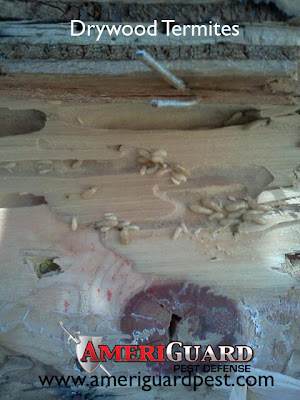According to the National Pest Management Association, termites cause an estimated 5 BILLION dollars in damage each year.
Most homes are constructed from wood materials and the diet of a drywood termite is just that...WOOD! It's a match made in heaven for the termite, but a horrible headache and expense for a homeowner that has discovered evidence of drywood termites. Fortunately, a licensed and experienced termite inspector AmeriGuard Pest Defense can help navigate the entire process from start to finish and take some of the stress away from you.
Drywood termites are different than their subterranean counterparts. Drywood termites do not need a moisture source or contact with soil to survive. Rather, drywood termites feed on dry wood that is above ground, namely the framing materials, eaves, rafters, roof tails, window sills and any other wood found in a structure.
DRYWOOD TERMITE EVIDENCE
Evidence that drywood termites are feeding on the cellulose material in your home can come in some different forms.
- Drywood termite swarmer
- Drywood termite pellets
- Drywood termite wings
- Drywood termite kick holes
- Drywood termite damaged wood
DRYWOOD TERMITE SWARMERS
After several years when a drywood termite colony matures, pairs of swarmers take flight to establish new colonies. Drywood termites swarm when there is a rise in temperature. Drywood termites are not great fliers and often travel short distances with the help of wind currents.
DRYWOOD TERMITE WINGS
Once the swarmers settle, they shed their wings. Homeowners sometimes report finding wings on exterior window screens or interior window sills.
DRYWOOD TERMITE PELLETS & KICK HOLES
Drywood termites produce pellets, which is simply drywood termite fecal matter. The pellets are then expelled out of their galleries (hollowed out portions of chewed wood) through kick holes. These pellets collect in piles or scattered about if the distance below is great.
 |
| Drywood termite pellets have fallen to the bottom of a subarea floor from the floor above in this home with a raised foundation. |
 |
| Drywood termite pellets are expelled from kickout holes. |
 |
| Drywood termites chew wood creating hollowed out galleries. |
 |
| New drywood termite pellet evidence is being collected directly from the kickout holes |
DRYWOOD TERMITE WOOD DAMAGE
Drywood termites chew wood and create hollowed out galleries, which threaten the integrity and support of the wood. |
| Drywood termites cause damage by eating wood, which threatens the structural integrity of buildings. |
Most homeowners do not realize that they have a drywood termite problem until they see the warnings signs mentioned above. Evidence of swarmers, missing wings, kick holes, piles of pellets and hollowed out wood members are all quite obvious signs of termites. Unfortunately, these signs are not usually visible until a termite colony has been well established for quite some time, usually a number of years.
AmeriGuard Pest Defense is experienced and licensed to perform several different termite treatments depending on the findings of each individual home that is inspected for wood destroying organisms. If you see termite evidence or suspect a termite infestation, do not hesitate to call your termite professionals for an inspection. We offer free limited inspections to residential homeowners. Full inspections are recommended and available for a nominal fee. Once the inspection is completed, you will receive a Wood Destroying Organism (WDO) Report with all of the Section I and Section II item findings as well as recommendations that fit your unique situation. Local treatment options may be available to you instead of a fumigation.
For more information and additional pictures of fumigations and termite treatments, please visit us on Facebook.
AmeriGuard Pest Defense is experienced and licensed to perform several different termite treatments depending on the findings of each individual home that is inspected for wood destroying organisms. If you see termite evidence or suspect a termite infestation, do not hesitate to call your termite professionals for an inspection. We offer free limited inspections to residential homeowners. Full inspections are recommended and available for a nominal fee. Once the inspection is completed, you will receive a Wood Destroying Organism (WDO) Report with all of the Section I and Section II item findings as well as recommendations that fit your unique situation. Local treatment options may be available to you instead of a fumigation.
For more information and additional pictures of fumigations and termite treatments, please visit us on Facebook.

good work!! thanks for the wonderful information you have provided about the Termites
ReplyDelete